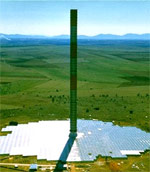
Solar tower project in Australia could represent the future of clean energy
Thursday, January 12, 2006 by: Ben Kage
Tags: alternative energy, solar tower, fossil fuels
- Newly released JFK files reveal Pentagon's role in creating Lyme disease and covid in the same lab
- Woman contracts WORLD'S DEADLIEST VIRUS after unknowingly being given the WRONG VACCINE
- Kiss Your Genetic Privacy Good-Bye! 23andMe Gets Green Light to Sell Your Intimate Genetic Details to Anyone They Want
- AI weather model outperforms traditional forecasts, boosts accuracy by 20%
- Revolutionize your diet with pomegranate: The miracle juice for gut health and metabolism
- Advisory: Ex-FBI agent exposes likely ATF honeypot operation selling illegal Glock switches
- The case for locking up the Deep State's biggest hatchet man...
- Analysis: The coming economic collapse, a mass uprising and Trump's three secret weapons to halt the growing revolt
- At least 75 percent of Americans are unknowingly MEDICATED FOR STUPIDITY by fluoridated water – Utah now banning it
- Sweden's migrant crisis deepens as failed green energy venture leaves thousands jobless, exposes systemic collapse
- U.K. unveils controversial pandemic preparedness tool: A double-edged sword?
- Trump administration CUTS FUNDING to Gavi, the Vaccine Alliance - a major blow to the Bill Gates-backed entity
- DHS Secretary Kristi Noem plans to dismantle FEMA
- Health Ranger Report: Ashton Forbes discusses TELEPORTATION ORBS and their role in MH370 disappearance
- Pediatric dentist exposes fluoride dangers as more states ban toxic water additive
- We are closer to all-out war in Europe, in Asia, and in the Middle East than most people realize
- Can special diets and supplements help kids with autism? A new research offers hope and hints at what works
- Gold reaches all-time high amid escalating trade tensions
- Newly released JFK files reveal Pentagon's role in creating Lyme disease and covid in the same lab
- Analysis: The coming economic collapse, a mass uprising and Trump's three secret weapons to halt the growing revolt
- Trump nominates VACCINE ZEALOT Susan Monarez to lead the CDC, sidelining RFK Jr.'s reform efforts
- Trump's greatest betrayal so far: Accelerating Middle East wars, silencing dissent, and serving Zionist masters
- CDC finally halts $11 billion COVID funding scam as health officials admit the ‘pandemic’ was a fraud
- The hidden dangers in your kitchen: How cooking methods impact diabetes, cancer and aging
- BEWARE: USDA allows genetically engineered vaccines to infiltrate organic food production
- Obama accused of laundering USAID funds to fuel global protest movements, regime change operations
- DEADLY DECEPTION: How COVID vaccines increased mortality rates and why authorities hid the truth
- Here are TEN all-natural ways to protect your garden without using harmful chemicals
- Dr. Mike Yeadon releases 15-minute testimony - WATCH - about genocidal intent of COVID “vaccines”
- Festive flavors: The sweet history, nutritional profile and health benefits of pecan pie
- Big Pharma's media takeover: How drug companies bought the news - and your health
- Dr. Suzanne Humphries makes bombshell appearance on Joe Rogan podcast, exposing vaccine industry deception back to POLIOMYELITIS
- Elon Musk: Aliens could be here on Earth RIGHT NOW
- 5 Simple steps to boost your brainpower: How to strengthen executive function in a distracted world
- Trump reverses course on Gaza plan, says “nobody is expelling Palestinians”
- California's social media censorship law struck down: A victory for free speech or a threat to online safety?
- Newly released JFK files reveal Pentagon's role in creating Lyme disease and covid in the same lab
- EPA advisor admits the agency is funneling billions to climate groups ahead of Trump’s return to White House
- California's social media censorship law struck down: A victory for free speech or a threat to online safety?
- Dr. Mike Yeadon releases 15-minute testimony - WATCH - about genocidal intent of COVID “vaccines”
- The Health Ranger releases “Vaccine Zombie” song and music video, using AI-animated zombies for the music video
- Florida takes a stand: DeSantis proposes permanent ban on mRNA vaccine mandates
- The pandemic as a tool for INDOCTRINATION: Understanding “The Indoctrinated Brain” by Dr. Michael Nehls
- “Why we influenced the 2020 elections”: Facebook files reveal the coordinated effort to bury the Hunter Biden laptop story
- Mike Adams releases country western hit single: Goin’ Back in Time is Comin’ Home
- Mike Adams releases music poetry sensation: A Child of God
- Unpacking the Lies That We’ve Been Fed – new song and music video released by Mike Adams, the Health Ranger
- Michigan sheriff announces criminal investigation into 2020 election crimes, Dominion Voting Systems
- Migrants are taking advantage of recent hurricanes to scam residents and loot their homes
- House Intelligence Committee calls for the ARREST and PROSECUTION of Dr. Anthony Fauci
- Rep. Nancy Mace introduces bill to ban biological males from female facilities on federal property
- Peter Rost exposes Big Pharma corruption in his book “The Whistleblower: Confessions of a Healthcare Hitman”
- Former horse rancher and 6,000 other plaintiffs are suing Syngenta after paraquat exposure led to Parkinson's Disease
- Mike Adams releases new song and music video: Nothing More Disgusting Than a Globalist
- Red Cross issues warning to stop blood plasma donations from vaccinated people
- Scientists confirm: GENIUS brain function can be spontaneously unleashed in humans without any apparent cause
- EPA advisor admits the agency is funneling billions to climate groups ahead of Trump’s return to White House
- HYSSOP: What research reveals about the health benefits of this ancient holy herb
- Two containers with completed ballots fall out of truck in Florida
- Fully vaccinated about to see “tsunami” of illness and death, warns virologist
- Global leaders unite to clamp down on “misinformation” with UN-backed Cascais Declaration
- BREAKING: 2025 NDAA authorizes mandatory military draft of WOMEN across America… as Pentagon pursues global NUCLEAR war with both Russia and China at the same time
- Michael Yon warns of a ZIONIST TAKEOVER in Trump’s second administration
- BOMBSHELL: DNA testing kits are a SCAM to develop ethnic-specific bioweapons
- Ozempic and Wegovy weight loss drugs are injectable LIZARD VENOM PEPTIDES that may unleash a devastating wave of organ failure… side effects align with symptoms of SNAKE BITES
- Israeli soldiers accused of even more torture and abuse in the West Bank
- These 13 countries just signed an agreement to engineer a global FAMINE by destroying food supply
- NASA admits that climate change occurs because of changes in Earth’s solar orbit, and NOT because of SUVs and fossil fuels
- RFK Jr. clears key hurdle: Sen. Susan Collins backs controversial HHS nominee, signaling a new era for health policy
- Sermon 30: How Jesus reveals Caesar’s FAKE CURRENCY and FALSE AUTHORITY
- Coriander seeds: Ancient medicine backed by modern science
- Arizona officials claim Maricopa County needs 10-13 days to tabulate results of the election
The Solar Mission Project's focus is a solar tower powered by physics. Originally based on a concept called the solar chimney -- a name that was abandoned because of the negative environmental connotations of a "chimney" -- the hollow tower would be 1 kilometer tall, making it the tallest manmade construct in the world (a title currently ascribed to Canada's CN Tower, but claims made to that title by any modern building are sketchy at best, and this site explains why: tallestbuildingintheworld.com).
The tower would be surrounded by a 25,000-acre, transparent circular skirt of greenhouse panels, which would warm the air trapped underneath to about 95 degrees Fahrenheit above the ambient temperature. The cool air at the top of the 400-feet-in-diameter tower would then draw the hot air up from ground level at a speed of roughly 35 miles per hour, which in turn would drive the 32 turbines around the bottom half of the tower. The turbines provide around 200 megawatts of electricity. Click here to see an artist's computer-generated rendition of the tower and how it will work.
The tower's energy output is approximately equivalent to a small nuclear power station, and could power up to 200,000 average homes, as well as eliminate the production of up to 900,000 metric tonnes (830,000 U.S. tons) of greenhouse gasses. If this project takes off as successfully as EnviroMission hopes, they plan to build more towers in order to power larger populations.
These facts make it a highly attractive alternative power source, to the point that the Australian federal government awarded the Solar Mission Project "Major Project Facilitation Status," which means the government considers the project to be of major public interest and has given it moral backing, and it will likely be fast-tracked by any government agencies it must meet the approval of.
The Solar Mission Project is an attractive alternative power source proposition because it can achieve the same goal as a windmill farm without depending on the wind to generate power. Ostensibly, the tower can run 24 hours a day using stored heat. The same major drawback of windmill farms -- the clamor of locals who say the power sources will be an eyesore to whatever region they are proposed to be built in -- is shared by the solar tower on a somewhat larger scale. The kilometer-tall construct would be able to be seen from up to 80 miles away at ground level, and would even be visible from space. However, EnviroMission has picked a fairly remote location that has great exposure to sunlight: The Buronga district of the Wentworth Shire in New South Wales, Australia. The company does not seem to expect much resistance from the local populace.
EnviroMission owns the license to the solar tower design, originally developed by German structural engineering company Schlaich Bergermann and Partner (SBP) -- specifically by Professor Jörg Schlaich, who successfully utilized a solar tower on a smaller scale than EnviroMission is proposing near Manzanares, Spain for seven years. That 656-foot tower provided five megawatts of power for the surrounding region from 1982 to 1989, and the data from it is currently being used as the basis for the 200-megawatt version proposed by EnviroMission; the nature of the tower's operation means the power output increases exponentially with its size.
Despite the project's potential to shatter world records for its height, many people are going to be most concerned with cost. Some projections put that number anywhere from $500 million to $750 million U.S. dollars, but in a Wired.com interview, EnviroMission Chairman Roger Davey declined to give a specific cost estimate. He did, however, mention that EnviroMission is looking at two new engineering innovations that should help reduce the cost of constructing the tower.
EnviroMission Limited is currently working on the "Final Feasibility" phase of its solar tower project, which, according to the company's website, enviromission.com.au, "involves collaboration and project partnering to validate the economics of the project." One of the obvious obstacles to the company was also covered in the Wired.com article, in that investors may have to wait 10 years or more to see a return on their investment, meaning the project is likely to need government funds before it can begin construction.
On Sept. 20, the company announced that it would build a 50-megawatt version in the interim, much like the Schlaich Bergermann version in Spain. A press release (PDF format) on the EnviroMission website states that significant improvements have been made to existing technology, thereby improving the potential energy yield of a smaller tower, but the information makes it unclear whether this 50-megawatt version will replace the proposed 200-megawatt version, and a request for clarification went unanswered at press time.
However, in all likelihood, the future of this technology as a whole is more dependent on the success of the 200-megawatt version. The sheer scope of the project and the power it could generate means the data from its construction and operation would likely be the example by which all such future projects are judged. It has already seen one setback -- presumably from difficulties proving the project's feasibility and results -- as construction on the tower was supposed to have begun in 2003, but current projections put the start date at sometime in 2006.
The solar tower is not the only solar conversion technology being explored right now -- along with traditional solar panels, solar trough design and solar dish/Stirling design are being researched -- but as with any solar power technology, they tend to lose the majority of the energy they collect during its conversion into power. For example, the average solar panel has a conversion efficiency of about 12 percent.
Examples of solar trough design (also known as a parabolic trough) have been built with solar efficiency of up to 20 percent. It is built as a long parabolic mirror, usually constructed along a north/south axis and able to rotate to track the movement of the sun, which reflects concentrated sunlight onto a Dewar tube (kind of like a long, open-ended Dewar flask). Heat-transfer liquid (usually oil) runs through the Dewar tube, and transfers heat to a standard steam turbine. Some of these plants have been built with an energy efficiency approaching 20 percent.
The solar technology with the highest energy efficiency is the solar dish/Stirling system, which has a conversion efficiency of about 30 percent. A solar dish -- built of concave mirrors that reflect the sun's energy into a receiver -- utilizes a sun-tracking system to keep the dish pointed toward the sun. The energy absorbed by the receiver heats working gas (gas that is continually recycled and not consumed), making it expand, and then the gas is allowed to cool. The rising and falling pressure drives an engine's piston, and this motion is converted into mechanical power.
The solar tower actually has the lowest conversion efficiency at less than 2 percent. The reason the tower is still a viable choice as a source of solar power is that its sheer scale and undeniable simplicity means its economic efficiency could be equal to the more energy-efficient methods, or even greater.
With the ability to replace a small nuclear power plant (and, obviously, multiple towers could replace a large nuclear power plant), 24 hours of power and zero emissions, the solar tower seems like an almost perfect solution to the problem of gathering large amounts of renewable energy, without dumping toxic waste into the environment. Even the tower's low efficiency and high cost seem like small obstacles next to what the world stands to gain in the way of clean energy. The only real obstacle is, of course, money. With any luck, the current energy stresses being felt the world over will serve as inspiration to those with deep pockets to fund the Solar Mission Project, or something like it.
Alternative energy at FETCH.news
Get independent news alerts on natural cures, food lab tests, cannabis medicine, science, robotics, drones, privacy and more.
Take Action: Support Natural News by linking to this article from your website
Permalink to this article:
Embed article link: (copy HTML code below):
Reprinting this article:
Non-commercial use OK, cite NaturalNews.com with clickable link.
Follow Natural News on Facebook, Twitter, Google Plus, and Pinterest
Science News & Studies
Medicine News and Information
Food News & Studies
Health News & Studies
Herbs News & Information
Pollution News & Studies
Cancer News & Studies
Climate News & Studies
Survival News & Information
Gear News & Information
News covering technology, stocks, hackers, and more



"Big Tech and mainstream media are constantly trying to silence the independent voices that dare to bring you the truth about toxic food ingredients, dangerous medications and the failed, fraudulent science of the profit-driven medical establishment.
Email is one of the best ways to make sure you stay informed, without the censorship of the tech giants (Google, Apple, Facebook, Twitter, YouTube, etc.). Stay informed and you'll even likely learn information that may help save your own life."
–The Health Ranger, Mike Adams













































